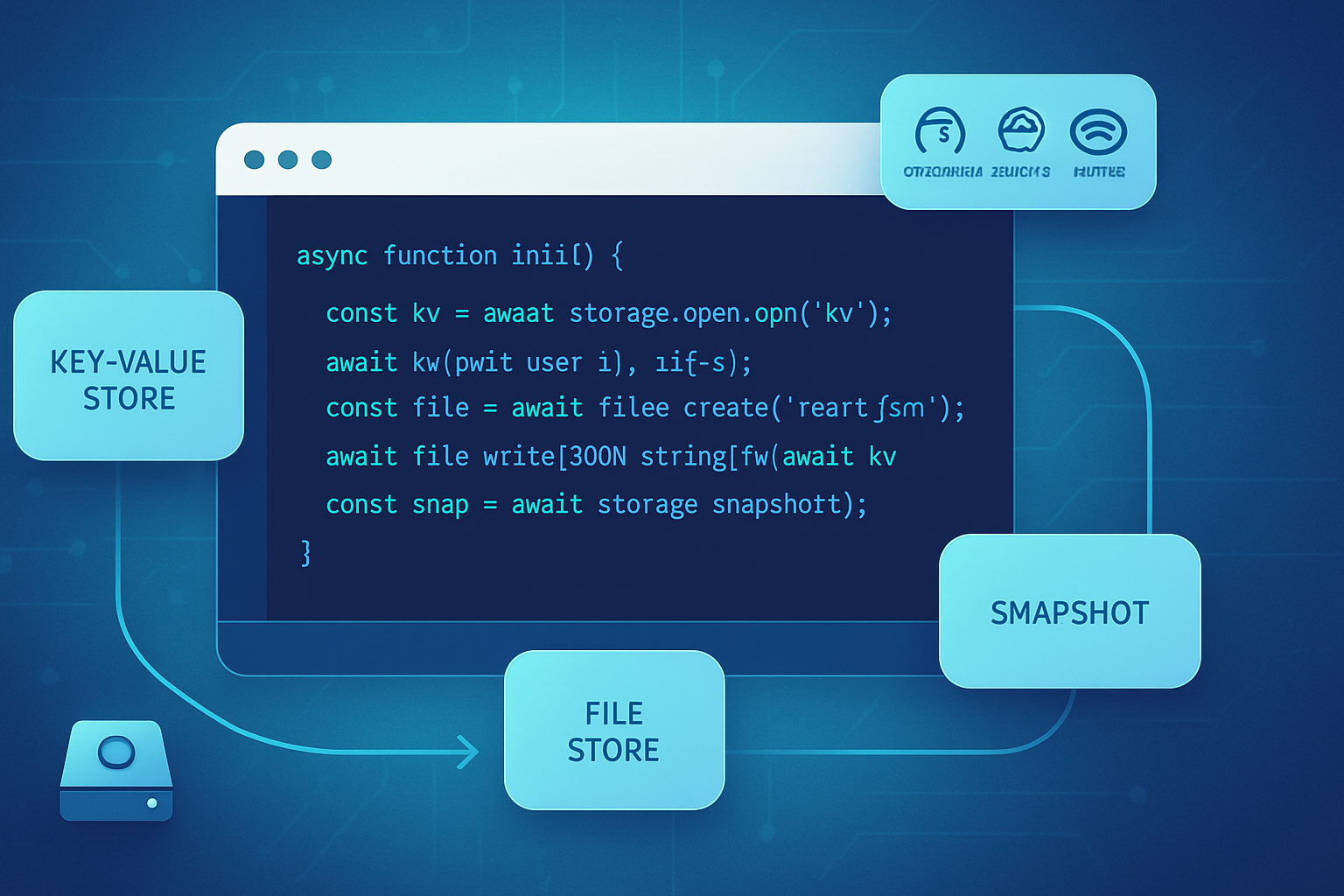· deepdives · 8 min read
Navigating the Future: How Storage Foundation API is Revolutionizing Data Management in JavaScript
Discover how the emerging Storage Foundation API reshapes client-side data management. Learn its architecture, practical JavaScript patterns, advantages over IndexedDB and localStorage, and real-world use cases for modern web apps.

Introduction - what you’ll gain
By the end of this article you’ll be able to: decide whether the Storage Foundation API fits your next web project, understand its architectural building blocks, and adopt practical JavaScript patterns for large, durable, and predictable client-side storage. Read on to learn how this emerging API promises to simplify complex storage needs for PWAs, offline-first apps, and data-heavy web tools.
What is the Storage Foundation API (at a glance)
The Storage Foundation API is an emerging browser API that provides higher-level, site-configurable storage primitives and management for client-side data. Unlike single-purpose APIs like localStorage, the Cache API, or the File System Access API, Storage Foundation aims to give sites clearer control over durable storage: how it’s organized, its lifecycle, and how browsers can manage quotas and eviction.
This API is being standardized in community groups and progressively implemented in Chromium-based browsers. It’s not a drop-in replacement for existing primitives - instead it sits above them as a structured, unified way to create, name, and manage “storage foundations” (logical containers) for your app’s data.
Key benefits in one line: predictable persistence, clearer naming and partitioning of data, richer lifecycle semantics, and better tooling for large, offline-capable web applications.
The architecture - primitives and responsibilities
At a conceptual level the Storage Foundation API introduces a few core ideas (terms may vary as the spec evolves):
- Storage foundation (or container): a named, durable container for data your site manages. Think of it as the app-level root for all your files, records, or key-value stores.
- Named stores/collections: typed sub-stores inside a foundation (for example: key-value store, record store, file store). These provide clearer organization than a single IndexedDB blob.
- Lifecycle and policy metadata: the foundation carries metadata such as expected lifetime (session, durable, versioned), user-visible size, and eviction policies.
- Quota and storage manager integration: the browser can reason about these foundations when deciding quota, eviction, or when offering storage-related UI (e.g., settings or prompts).
- Optional transactional/snapshot semantics: foundations can offer atomic operations and snapshots to make complex data updates safe and simpler.
Architectural responsibilities are split like this:
- Your app defines and uses foundations to store data.
- The browser provides durable on-disk storage, enforces policies, and surfaces UI/permissions if needed.
- The developer and browser collaborate on lifecycle decisions (for example: automatic eviction of an ephemeral foundation vs explicit user-managed storage).
This gives developers a predictable surface for persisting large, structured data while allowing the browser to manage system-level constraints responsibly.
How it compares with today’s storage options
Short answer: Storage Foundation is complementary, not purely competitive. Long answer: here are practical differences.
localStorage
- Pros: synchronous, simple key/value; works everywhere.
- Cons: tiny capacity, blocking API, no schema or lifecycle control.
- Where Storage Foundation wins: large capacity, non-blocking, structured stores, explicit lifecycle.
IndexedDB
- Pros: asynchronous, indexed structured storage in the browser.
- Cons: complex API surface, subtle versioning and migration challenges.
- Where Storage Foundation wins: clearer containerization and lifecycle control, built-in ergonomics for named stores and snapshots; can underpin or be implemented on top of IndexedDB.
Cache API (service worker cache)
- Pros: ideal for request/response caching and HTTP resources.
- Cons: not ideal for general purpose structured data.
- Where Storage Foundation wins: better for app-owned data and arbitrary file-like assets, with stronger semantics around durability and eviction.
File System Access API
- Pros: fine-grained file operations and user-granted access to the platform filesystem.
- Cons: user gestures required for access, UX patterns differ from persistent app-managed stores.
- Where Storage Foundation wins: intended for app-managed durable storage without explicit per-file user prompts, yet still allowing robust file semantics when needed.
In many deployments the Storage Foundation API will interoperate with these APIs. For example, a storage foundation might use IndexedDB or the file system behind the scenes, but present a simpler, higher-level API to app code and a clearer contract to the browser.
Practical use cases
Progressive Web Apps with heavy offline needs
- Example: a note-taking or productivity app that must store documents, attachments, and user state reliably across devices (and across app updates).
Rich media editors and DAM (digital asset management)
- Example: an in-browser photo or video editor that needs to keep large originals, intermediate edits, and derived assets.
Machine learning models and datasets
- Example: caching large model weights or embeddings for client-side inference and incremental updates.
Enterprise or industry apps with large datasets
- Example: mapping apps, CAD viewers, or analytics tools that require predictable local caches for responsiveness.
Migration and backup tooling inside web apps
- Example: versioned foundations that make it easy to snapshot an app state, upload it to cloud, or perform a rollback.
JavaScript patterns and example workflows
Below are idiomatic patterns you can expect to adopt. The exact API surface will evolve, so examples are pseudo-realistic and focus on intent rather than precise method names.
- Create or open a foundation
// Pseudocode - illustrate intent, not an exact API call
const foundation = await navigator.storageFoundation.open({
name: 'my-notes',
version: 1,
expectedLifetime: 'durable',
});- Use typed stores inside the foundation
// Key-value store
const kv = foundation.getKeyValueStore('settings');
await kv.put('theme', 'dark');
const theme = await kv.get('theme');
// File store
const files = foundation.getFileStore('attachments');
await files.write('photo-001.jpg', fileBlob);
const readBlob = await files.read('photo-001.jpg');- Snapshots and safe updates
// Start a transaction, make multiple changes, then commit atomically
await foundation.transaction(async txn => {
await txn.kv.put('draft', draftBody);
await txn.fileStore.write('draft-attachment', blob);
});
// Or create a snapshot for a user to export
const snapshot = await foundation.createSnapshot();
// snapshot can be uploaded or saved via File System API- Lifecycle and housekeeping
// Signal that this data is temporary
await foundation.setPolicy({ expectedLifetime: 'ephemeral' });
// Check storage usage
const usage = await foundation.getUsage();
console.log(`Foundation uses ${usage.bytes} bytes`);These patterns show how apps can reason about named containers rather than juggling ad-hoc IndexedDB databases, caches and file handles across app code.
Advantages for developers and users
- Predictability: foundations let apps express expected lifetimes and intent. That reduces surprises when the browser frees space.
- Discoverability: a single, named surface for an app’s data is easier to document, backup, and visualize in devtools or browser settings.
- Safety: transactional and snapshot semantics reduce the chance of corruption during updates.
- Scalability: better primitives for large binary blobs and typed stores simplify building data-heavy web apps.
- UX and privacy: the browser can expose clearer storage controls for users (inspect how much space a given foundation uses, delete it, or export it) rather than obscure domain-level storage quotas.
Migration strategies from IndexedDB / Cache to Storage Foundation
- Start by identifying logical containers in your app (e.g., user-attachments, caches, settings).
- Map each container to a named foundation or named store within a foundation.
- Implement an upgrader path: on first run, read legacy IndexedDB or Cache entries and import them into your foundation container.
- Use snapshots to provide user-visible backups during migration.
- Keep telemetry during rollout to detect size and performance regressions.
A phased migration preserves user data and lets you progressively optimize storage layout.
Security, privacy, and operational considerations
- Origin scoping and consent: foundations are intended to be origin-scoped (or permissioned) so cross-origin access should remain controlled. The browser may add UI for user consent for very large or long-lived foundations.
- Eviction and user control: even durable foundations are subject to device constraints; declare expectedLifetime to help browsers make intelligent eviction decisions.
- Encryption and local security: the API may provide options to encrypt foundation contents or integrate with platform-provided secure stores; until such features are standardized, use client-side encryption where necessary.
- Malware and data-safety: foundations increase the risk surface if a malicious site abuses large amounts of disk; browsers will likely require stronger UX affordances to mitigate this (size warnings, permission prompts).
Performance and device considerations
- Benchmarks will vary by browser implementation and backing store (IndexedDB, filesystem, etc.). Expect faster startup and simpler migration paths compared to fragmented ad-hoc use of multiple APIs.
- For large binary data prefer file-like stores rather than stuffing big blobs into IndexedDB records: file primitives can avoid memory pressure and serialization overhead.
- Monitor storage usage carefully and provide app-level housekeeping (prune caches, compress data, delete stale snapshots).
Adoption and the road ahead
The Storage Foundation API is part of a broader trend: browsers exposing higher-level, deliberate primitives that match real-world app needs instead of only low-level building blocks. Adoption will be iterative:
- Browser vendors will continue implementing foundational features (initially in Chromium-family browsers).
- Tooling (devtools) will evolve to surface foundations in UI so developers and users can inspect and manage them.
- Patterns and libraries will emerge to provide migration helpers (e.g., importers from IndexedDB) and ergonomic SDKs.
Keep an eye on the WICG proposal and browser release notes from Chromium-based vendors for concrete shipping timelines and API shape.
Real-world checklist - should you adopt it now?
Yes, if:
- Your app stores large amounts of structured data or files and needs predictable lifecycle.
- You build complex offline-first features that require snapshots and atomic updates.
- You want simpler, named containers instead of many ad-hoc IndexedDB databases.
Wait if:
- You need maximum cross-browser parity today (the API is still emerging).
- Your storage needs are tiny and simple (localStorage or IndexedDB suffice).
If you’re building for progressive adoption, design migration paths now and feature-detect the API at runtime.
Further reading
- WICG Storage Foundation Proposal (spec draft): https://wicg.github.io/storage-foundation/
- MDN - IndexedDB API: https://developer.mozilla.org/en-US/docs/Web/API/IndexedDB_API
- MDN - File System Access API: https://developer.mozilla.org/en-US/docs/Web/API/File_System_Access_API
- Web.dev and browser platform posts on progressive web storage patterns: https://web.dev/search/?q=storage
Conclusion - why this matters
The Storage Foundation API represents a shift from ad-hoc, low-level browser storage primitives toward named, policy-aware, and durable containers that map directly to app needs. For developers building offline-first, data-heavy, or complex client-side apps, this reduces the engineering overhead of data migrations, improves user transparency, and unlocks new UX patterns (snapshots, atomic updates, clearer deletion). In short: it makes reliable client-side data management less of an implementation puzzle and more of a predictable engineering surface.
Adopt the idea now. Plan migrations. Measure and test. And when the API is broadly available, you’ll reap cleaner architecture and better user experiences.



